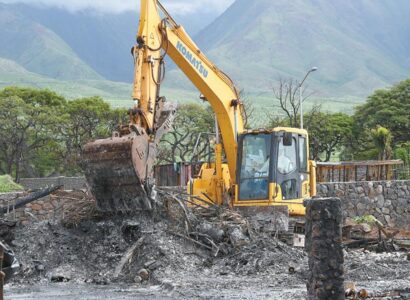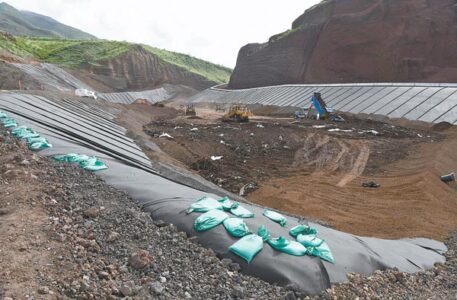Final resting place for Lahaina fire debris needs public input
As the cleanup of Lahaina steadily ramps up, Maui County officials are asking the community to help decide the final resting place for an estimated 300,000-400,000 tons of contaminated ash and debris.
Maui County Director of Environmental Management Shayne Agawa laid out the county’s top three options for the permanent disposal site during Wednesday evening’s Disaster Recovery Community Update at Lahaina Civic Center. The choices include two locations on the west side, Wahikuli and Crater Village, and the Central Maui Landfill.
The county is urging community members to log on to mauirecovers.org and take a survey that will help determine where ash and debris from the August 2023 fires in Lahaina will be permanently stored. The survey closes Feb. 15. Results are to be released Feb. 21 and the location is scheduled to be announced Mar. 1.
Agawa said the selection process started with hundreds of possibilities and was narrowed to eight before the top three were named. Criteria included: time to acquire land, proximity to Lahaina, access into and out of the site, constructability, surface water management, adjacent property impacts, distance to ground drinking water, distance to residential neighborhoods, schools, hospitals and environmental concerns like tsunamis and flooding. Public input added: historic preservation, cultural sensitivity, distance to the coastline and prevailing winds.
“There is no perfect site,” Agawa admitted.
In his presentation, Agawa said each of the top three has advantages and disadvantages. Wahikuli and Crater Village are both located near the Olowalu Temporary Debris Storage site where debris is now being deposited. Both parcels are undeveloped and government owned. The main disadvantages for the Wahikuli site is its proximity to the ocean and to an existing residential neighborhood. It has also been pegged for future housing. The 500-acre Crater Village property located uphill of the Wahikuli site is big enough to locate the disposal site away from neighborhoods and schools-at least ones that haven’t been built yet-but it is above the Underground Injection Control line, which means a greater possibility of contaminating potable groundwater. The Wahikuli site is below this line.
The Central Maui Landfill hits nearly every note but one, and it’s a biggie. It will take an estimated 40,000 truckloads to clear Lahaina of debris. At 50 miles a roundtrip, there could be substantial congestion and delays on Maui’s roads.
“We anticipate major traffic impacts, which includes roadway safety,” Agawa said.
Moving non-recyclables off the island is not a choice, said Maui County Mayor Richard Bissen.
“Shipping the debris off of Maui is not one of the options,” Bissen said at Wednesday’s meeting.
Agawa said concerns about the Olowalu Temporary Debris Storage site play a role in the accelerated timeline to choose a permanent location.
“There’s concerns about the debris being left at a temporary site at Olowalu,” Agawa said. “It’s a temporary site. It’s not meant to hold the debris for years and years, so we really need to find a final site that is designed to contain the debris. There’s also concerns that maybe we might lose some FEMA support, whatever that might be. We can’t expect FEMA to be here forever and ever supporting us.”
Bissen said FEMA, the Federal Emergency Management Agency, can help with temporary projects, but the permanent site will be left to the county to fund. He said FEMA can, however, help pay for the truckloads and debris removal.
On Thursday in Lahaina, the U.S. Army Corps of Engineers and its contractors had completed the cleanup of 30 properties and another 11 were underway. Before an Alio Street lot was cleared Thursday, personnel from the Army Corps joined the contractor and cultural advisors in the driveway to discuss what was to be done.
“We don’t start any work until everybody is on the same page,” said U.S. Army Corps of Engineers Zone Manager Leonard Bakker.
Bakker said 10 crews were working with excavators and front loaders in Lahaina Thursday and that was scheduled to be bumped up to 15 next week. The incremental buildup started with one crew and then two and five as they learned the mission. He said metals are being transported to Hammerhead Metals Recycling and concrete is going to HC&D to be recycled. Both central Maui businesses are located on Maui Veterans Highway.
Bakker said the top six inches of each property’s soil and ash is removed and transported to the Olowalu temporary site. The property is then tested for contaminants. If a test comes back with hazardous material, another six inches is removed. He said all samples to date have come back clean.
Work crews are operating in a variety of Lahaina residential neighborhoods. Bakker said the county set priorities based, in part, by trying to clear areas where existing houses remain standing so people might be able to move home sooner. He said more than 2,100 properties are eligible to submit Rights of Entry (ROE) to the county and, so far, 1,176 have been turned in. The Army Corps cannot clear a property without an ROE approved by the county. He predicted the residential cleanup would be finished in about a year.
Loads headed to Olowalu are “burrito-wrapped” in plastic to prevent contaminated soil from escaping. The full “burrito” is dumped. Trucks were arriving to the Olowalu site every ten minutes or so Thursday morning. A portion of the expansive bowl carved into the side of a cinder cone several hundred yards uphill from the coastline is still under construction. When completed, the site is designed to hold 500,000 tons of debris. It is lined with 80mm High Density Polyethylene (HDPE) geomembrane.
A lined catch-basin has been built below the disposal site to capture any flooding or runoff. Bakker said water collected in the basin is either sprayed back onto the site as dust control or disposed of.
When asked about concerns expressed by some residents that the temporary disposal site could foul groundwater or affect the reefs offshore, Army Corps Hawaii Wildfire Recovery Field Office Chief of Public Affairs Rick Brown expressed confidence in the efforts being made to protect the environment.
“There’s a lot of smart people working on this, a lot of people who care about doing this right so the people of Lahaina can start to rebuild, start to recover,” Brown said.
* Staff Writer Matthew Thayer can be reached at mthayer@mauinews.com
- A chainlink fence separates a Lahaina lot that has been cleared from one that has not Thursday morning. The Maui News / MATTHEW THAYER photos
- An excavator operator scrapes debris into a pile before loading it into the bed of a truck bound for Olowalu Thursday morning. The Maui News / MATTHEW THAYER photos
- A truck dumps a “burrito-wrapped” load at the Olowalu Temporary Debris Storage site Thursday morning. The Maui News / MATTHEW THAYER photos
- The Olowalu Temporary Debris Storage site is designed to hold 500,000 tons of ash and debris. The Maui News / MATTHEW THAYER photos







